Who Controls the User Experience? AMD’s Carrizo Thoroughly Tested
by Ian Cutress on February 4, 2016 8:00 AM EST#5 The Lenovo Y700 (Carrizo, FX-8800P + R9 385MX)
The Y700 pre-release unit we had access to didn't have a battery, or a wireless module. But it did have a ‘neat’ trick compared to the other APUs in this test, in that it is the 35W model of the AMD FX-8800P, which adds a bit more frequency in exchange for some additional power draw. Moving to 35W affords some benefits we’ll go into in a bit, although for some odd reason Lenovo didn’t take them here.
| Lenovo Y700 (Carrizo) Specifications | |
| Size and Resolution | 15.6-inch, 1920x1080 IPS |
| Processor | AMD FX-8800P (35W) Dual module, 4 threads 2.1 GHz Base Frequency 3.4 GHz Turbo Frequency |
| Graphics | Integrated R7 512 Shader Cores 800 MHz maximum frequency GCN 1.2 AMD R9 385MX Discrete GPU with 2GB GDDR5 512 Shader Cores 900-1000 MHz Core, 1200 MHz Memory GCN 1.2 Dual Graphics Not Available in Drivers |
| TDP | Chassis: 15W CPU: 35W |
| Memory | 16 GB in Single Channel Operation 2 x 8GB at DDR3L-1600 C11 Single Channel ONLY |
| Storage | 256GB Sandisk |
| Battery Size | None in our model 80Wh with 4 cell Li-ion design otherwise |
| WiFi | None in our model 802.11ac M.2 otherwise |
| Optical Drive | Optional |
| Dimensions | 15.24 x 10.91 x 1.02-inch 38.7 x 27.7 x 2.60 cm |
| Weight | 5.72 lbs 2.6 kg |
| Webcam | 1280x720 with array microphones |
| Ports | Memory Card Reader HDMI 2 x USB 3.0 + 1 x USB 2.0 Ethernet |
| Operating System | Windows 10 Home |
| Website Link | link |
The Y700 here is paired with a discrete graphics card, AMD's Radeon R9 385MX, which offers 512 streaming processors. The FX-8800P processor also has R7 graphics and 512 SPs at 800 MHz, and in theory one might think that these two automatically work with each other in dual graphics mode – but this design is not set up that way. So for this design, the user is paying for almost the same graphics design twice (though the discrete card has access to much faster memory), but one is essentially disabled or only comes on when the discrete card is shut off. Arguably one might postulate that the active idle power of the integrated graphics is lower than that of the discrete, but it seems expensive just for the sake of a few hundred mW. There could be another reason in display support, but it still seems odd. The user can however manually choose to invoke whichever graphics solution they wish from the Catalyst menu.
Another element of the design worth questioning is the memory. Carrizo as a platform does support dual channel memory, but it shares a design structure with Carrizo-L (Puma+) which is single channel only. As a result, a number of OEMs have designed one motherboard for both platforms, which means all Carrizo under that design are limited to single channel operation, reducing performance for the sake of some PCB design. This is an aspect we’ll get on to later, but it means that the Y700 has access to 16GB of DDR3L-1600 CAS 11 but in single channel mode. The fact that it is DDR3L-1600, even though Carrizo supports DDR3-2133, is another angle to tackle on how such a design can have performance issues.
For the other specifications, the Y700 gets a 1920x1080 IPS screen, a 256 GB Sandisk SSD and some Wi-Fi in an M.2 form factor. I say ‘some’ Wi-Fi, purely because our pre-production unit didn’t have any.
This low quality image of the insides shows the dual fan design for the 35W APU and discrete graphics, and we can confirm we didn’t see any throttling during our testing. The two memory modules, despite being part of a single channel design, sit on the right below the slim hard drive which we replaced with the 256 GB Sandisk SSD. There is also an M.2 slot next to this, though I believe this is SATA only, supporting form factors up to 2280.
Next to the M.2 slot is the bass speaker. The Y700 has an extra vent at the bottom for better sound, rather than muffled in a chassis:
The keyboard we had in our model was a mix English/Japanese variant, though the red backlight was easy to see through.
Brett actually has the Skylake variant in for testing, so I'll let him mull over the design a bit more, but on the sides:
The left gets a charging point, a USB 3.0 port, a multi card reader and a headphone jack. On the right are two more USB ports, a HDMI port, an expanding Ethernet port and a Kensington Lock hole.
Y700 Specific Testing
In the case of the display, out of those we tested it actually comes best in terms of color accuracy. While I don’t have a spectrophotometer to show you exactly in numbers, the colorimeter graph does the business:
Here red and blue are pretty much dead on accurate, but green is straying too low. The panel gives a good 1032 contrast ratio, with 0.216 nits at low brightness and 223 nits at peak. The peak isn’t very high, which might be a bit concerning in bright lights.
One of the downsides to these configurable TDP processors is that the ‘max TDP’ string doesn’t change. It is up to the OEM to do the firmware adjustments, but chances are they won’t open it up to regular users in case someone wants to put 35W through a chassis only designed to handle 15W. The way to tell is in the peak frequencies, and this one goes to eleven 3.4 GHz.
For the discrete GPU, we get 2 GB of dedicated memory and, thanks to the use of GDDR5, much greater bandwidth than just relying on DDR3 alone. The ‘CrossFire available’ message means that GPU-Z recognizes that the CPU and GPU can be both put to work together, but for whatever reason the drivers did not allow it when we tested.


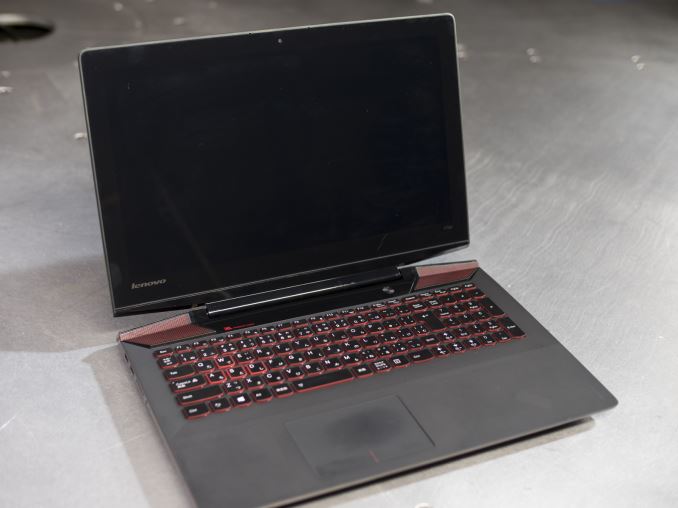






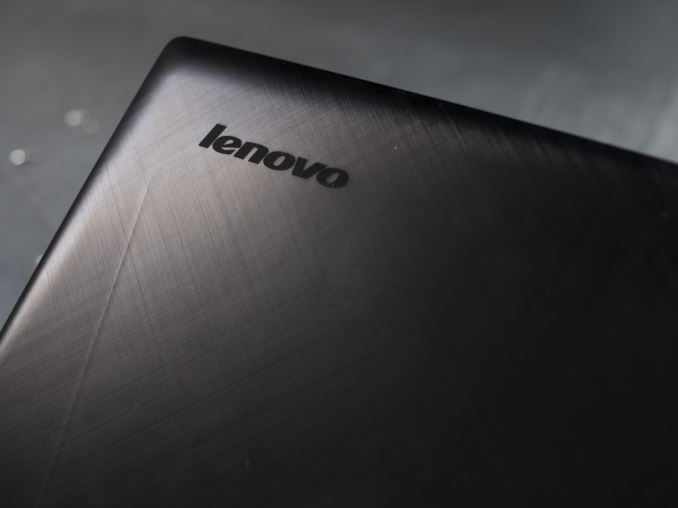
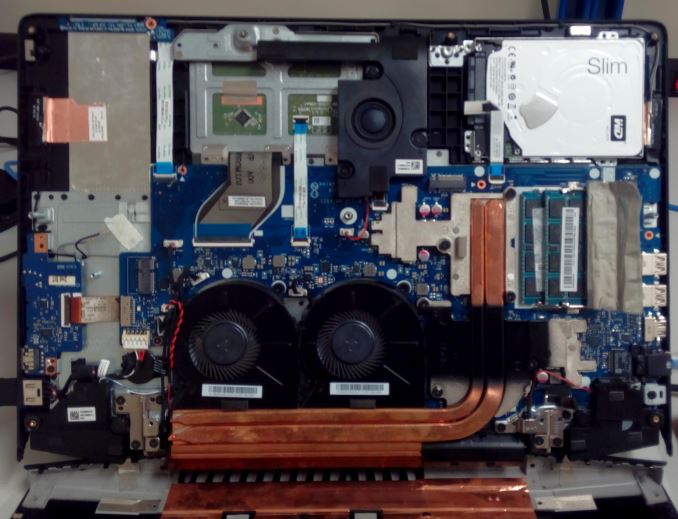
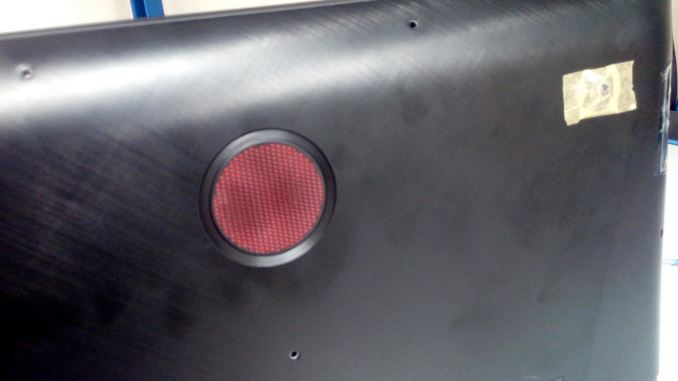
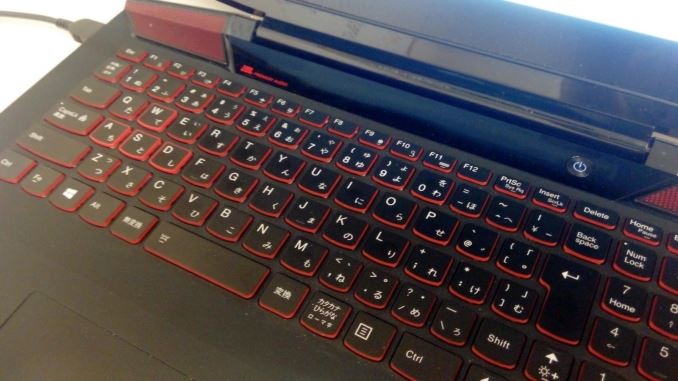

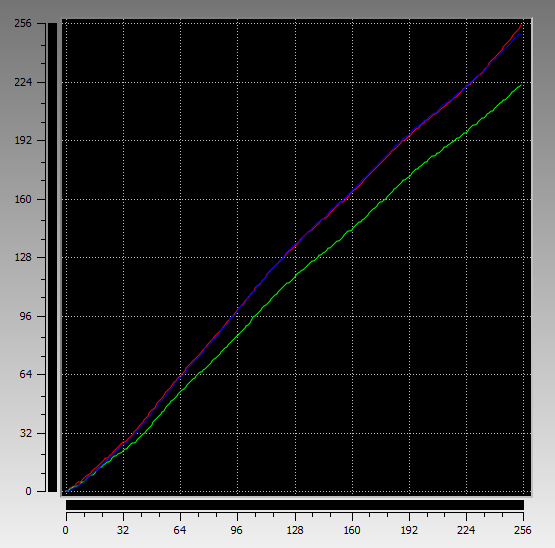
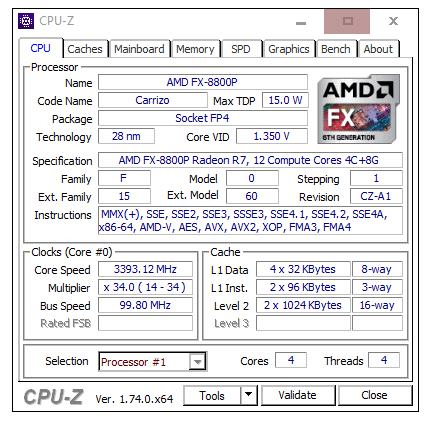
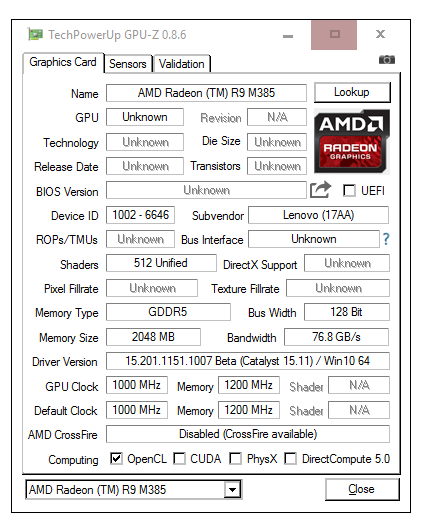








175 Comments
View All Comments
jakemonO - Wednesday, February 10, 2016 - link
no A12 core parts for the test? I can't find the A10 part on the HP websiote, only A8 & A12UtilityMax - Wednesday, February 10, 2016 - link
After a decade of hype since the ATI acquisition, nothing has changed. AMD has a massive OEM problem. Moreover, laptops have been outselling desktops for like a decade, yet AMD if you look at the history of AMD, it's hard to believe they ever really cared about portables. The Kaveri parts didn't even show up, while the Carrizo notebooks are already botched technology as explained in the article..gserli - Thursday, February 11, 2016 - link
I have to say that the $400 to $700 notebooks on sale are garbage.The IGPs are not strong enough for casual gaming like LOL and CS GO.
Crappy 5400RPM harddisk will make you want to throw the machine out of the window.
If you really need that little bit more performance.
Pay few hundred more. Or you can get a notebook that will hurt your arm if you carry it with one hand.
AMD needs to be more aggressive. Talk to the OEMs and give them better offer.
Convince them build a $700 notebook with 13 Inch 1080p IPS touch screen, 256GB SSD, 8GB RAM, A8 or A6 APU and below 1.5KG.
A lower end $600 one would work with 1366*768 IPS touch screen, 128GB SSD, 4GB RAM and A6 APU, below 1.5KG.
My $640 Asus TP300L is absolutely bullshit! I thought a mobile i5 would be enough for my daily use since I had a i5 desktop and was really satisfied with it.
CPU performance is not a issue nowadays. The IGP is slow, but I didn't expect it to be fast(Although the one on desktop is way more powerful).
The biggest problem is the GOD DAMN 5400RPM HARD DISK.
Not only did it affect the boot up speed. Every action I performed is awfully slow when there are some OS things running in background.
Only if I wait for 5 or 10 minutes after boot-up, then I can use it normally.
Please, kill all the 5400RPM Hard disk. They should not be in 2016.
farmergann - Thursday, February 11, 2016 - link
That's what I find so hilarious about all the Y700 6700hq lovers out there - all the CPU power in the world is relegated to potato status outside of b.s. benchmarks with that 5400rpm HDD. Save money with the FX8800p Y700 and buy an $80 250GB Samsung 850 Evo to slap in it...wow&wow - Thursday, February 11, 2016 - link
Will it be more appropriate to have "Additional" (Why not Update?) in the beginning, particularly the misleading pre-production stuff? Thanks for the article.farmergann - Thursday, February 11, 2016 - link
LOL, because the entire point of this article would be nullified. They didn't even bother comparing the FX8800p Y700 with the intels head to head outside of some DX9 garbage. Pitiful anandtech shills are pitiful. How many times did they mention Freesync? Yeah...silverblue - Friday, February 12, 2016 - link
To be fair, is there a point?xrror - Thursday, February 11, 2016 - link
"Some companies in the past have dealt with contra-revenue, selling processors at below cost or with deals on multiple parts when purchased together. Very few companies, typically ones with large market shares in other areas, have access to this. Some members of the industry also see it as not fighting fair, compared to actually just pricing the parts lower in the first place."I had to laugh so much as this. WHO COULD IT BE? MYSTERY!
It must be... Cyrix ! no? hrm. I give up. =P
dustwalker13 - Saturday, February 13, 2016 - link
still ... there is just no saving the bulldozer architecture, no matter how much they improve or iterate it.bulldozer and amd by proxy for normal users are synonyms for "just not as good as intel" and for a little more experienced users "that processor that cheated with its core count".
the few people who actually read articles like the one above and compare performance/value represent literally no market share.
the only way out for amd at this point is to create as much boom around their zen-cores as possible, get them out asap, hitch their little start to new buzzwords like hbm, old buzzwords like rage and hope they can actually deliver the performance figures needed in the first reviews to drive a wave of positive articles through the press. only then will they be able to get back into the market. i wish them the best, a surface 5 (non pro) with a low power zen apu on hbm sounds awsome ... i'd get one of those in a heartbeat.
yankeeDDL - Monday, February 15, 2016 - link
I own a Toshiba P50D-C-104. I read with interest this article and, albeit extremely helpful and rich of information, left some questions open, at least as far a I'm concerned.First of all, the P50D-C-104 costs <$600 and has an A10-8700P. I find this price range more relevant for home-users and, in general, for somebody interested in AMD offering.
1Kusd for a laptop with integrated GPU seems too expensive.
The P50D-C-104 has 2 DIMM slots; couldn't find for sure whether it is dual channel or not.
I am curios to know how it performs on some popular games against Intel's offering (at that price level, it would go against core i3, at best). In the page with comparison against Intel's offering there are almost only synthetic benchmarks: it would have been nice to compare on some actual games.
My point is that in the $1K range, there are many features that could add cost while not necessarily improving performance.